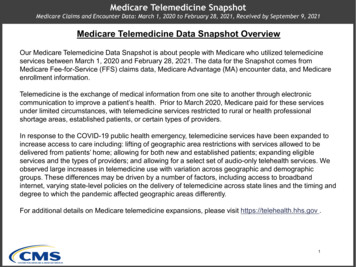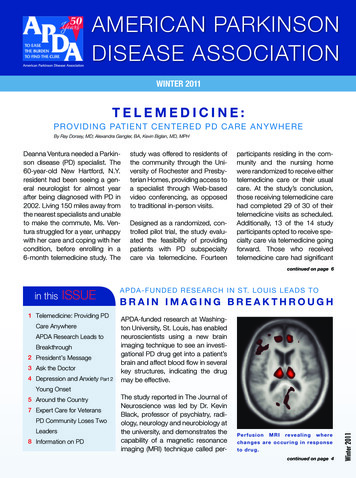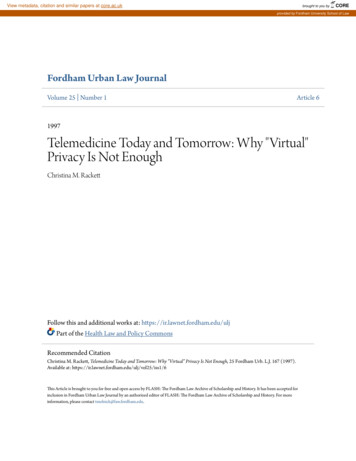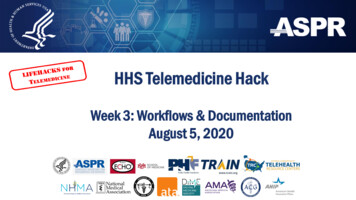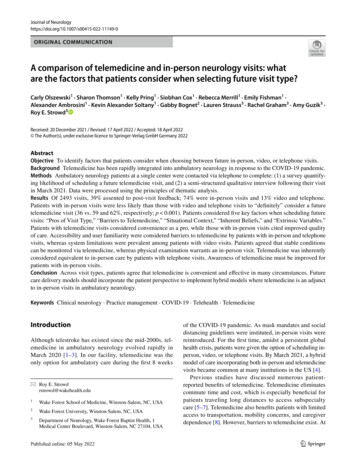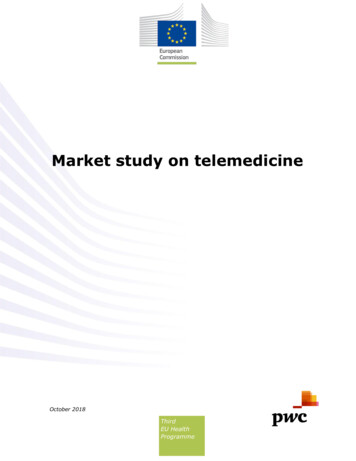
Transcription
Market study on telemedicineOctober 2018ThirdEU HealthProgramme
EUROPEAN COMMISSIONDirectorate-General for Health and Food SafetyDirectorate B — Health systems, medical products and innovationUnit B.3 — European Reference Networks and Digital HealthE-mail:sante-consult-b3@ec.europa.euEuropean CommissionB-1049 Brussels2
Europe Direct is a service to help you find answersto your questions about the European Union.Freephone number (*):00 800 6 7 8 9 10 11(*) The information given is free, as are most calls (though some operators, phone boxes or hotelsmay charge you).“This document has been prepared for the European Commission however it reflects theviews only of the authors, and the Commission cannot be held responsible for any usewhich may be made of the information contained therein.”More information on the European Union is available on the internet (http://europa.eu).Luxembourg: Publications Office of the European Union, 2018ISBNdoi: European Union, 2018Reproduction is authorised provided the source is acknowledged.Printed inPRINTED ON ELEMENTAL CHLORINE-FREE BLEACHED PAPER (ECF)PRINTED ON TOTALLY CHLORINE-FREE BLEACHED PAPER (TCF)PRINTED ON RECYCLED PAPERPRINTED ON PROCESS CHLORINE-FREE RECYCLED PAPER (PCF)3
LIST OF ABBREVIATIONSAALAmbient Assisted LivingADIIntegrated Home CareAIArtificial IntelligenceAITAustrian Institute of TechnologyAMAAmerican Medical AssociationARSRegional Health AgenciesATAAmerican Telemedicine onsumerBCEBefore the Common EraBLEBluetooth Low EnergyC2BConsumer-to-BusinessCAGRCompound Annual Growth RateCBTCognitive Behavioural TherapyCEACost Effectiveness AnalysisCEFConnecting Europe FacilityCEMACentral and Eastern Europe, the Middle East, and AfricaCENEuropean Committee for StandardizationCENELECEuropean Committee for Electrotechnical StandardizationCOPDChronic Obstructive Pulmonary DiseaseCTComputed TomographyCVDCardiovascular DiseaseDAREDatabase of Abstracts of Reviews of EffectivenessDG CONNECTDirectorate-General for Communications Networks, Content andTechnologyDKDenmarkDSMDigital Single MarketECEuropean CommissionECGElectrocardiogramECHIEuropean Core Health IndicatorsECHIMEuropean Community Health Indicator MonitoringEEAEuropean Economic AreaeHDSIeHealth Digital Service Infrastructure4
eHealthElectronic HealthEHRElectronic Health RecordERNEuropean Reference NetworkETSIEuropean Telecommunications Standards InstituteEUEuropean UnionFDAFood and Drug AdministrationFIRFonds d’Intervention RégionalGDPGross Domestic ProductGDPRGeneral Data Protection RegulationGHTFGlobal Harmonisation Task ForceGPGeneral PractitionerGSMAGSM AssociationHIMSSHealthcare Information and Management Systems SocietyHITHealth Information TechnologyHL7Health Level Seven InternationalHRHuman ResourcesHTAHealth Technology AssessmentsICERIncremental Cost-Effectiveness RatioICTInformation and Communication TechnologyIHEIntegrating the Health(care) EnterpriseIMDRFInternational Medical Device Regulators ForumIPHSIntegrated Personal Health/care ServicesISOInternational Organization for StandardizationITInformation TechnologyITU-TITU Telecommunication Standardization SectorJAJoint ActionKPIKey Performance IndicatorM2MMachine-to-MachineMCTMobile Cardiac TelemetryMDDoctor of MedicinemHealthMobile HealthMHLWJapanese Ministry of Health, Labour and WelfareMRIMagnetic Resonance ImagingNASANational Aeronautics and Space AdministrationNFCNear-Field Communication5
NHSNational Health ServiceNSTUniversity Hospital of North NorwayOADHome rsonal Connected Health AlliancePDAPersonal Digital AssistantQALYQuality Adjusted Life YearR&DResearch and DevelopmentSDOStandards Developing OrganisationSIMSubscriber Identification ModuleSIMPHSStrategic Intelligence Monitor on Personal Health Systems PhaseSIRMSocietà Italiana di Radiologia MedicaSMESmall and Medium-sized EnterprisesSWOTA method to evaluate Strengths, Weaknesses, Opportunities andThreatsTSBTechnology Strategy BoardUKUnited KingdomUSUnited StatesWHOWorld Health Organization6
Market study on telemedicineFinal ReportTABLE OF CONTENTSPrinted in . 3List of abbreviations . 4Table of contents . 7Abstract . 9Executive summary . 11Résumé . 14Synthèse . 16Introduction . 20Background . 20Objectives of the study . 23Key terms and concepts . 25eHealth and mHealth . 25Telemedicine. 25Telehealth . 251.Mapping and categorisation . 271.1. Analysis of telemedicine solutions . 271.1.1. Technical considerations . 281.1.2. Geographical distribution. 351.1.3. Healthcare-context characteristics . 401.1.4. Analysis of the status of telemedicine solutions . 461.2. Analysis of standards and guidelines . 481.2.1. Typology of issuing bodies . 481.2.2. Geographical spread . 491.2.3. Guideline/standard category . 491.2.4. Medical specialties . 522. Market analysis . 532.1. Market fundamentals . 542.1.1 Description of the solutions/products that make up the telemedicine market . 542.1.2 Geographical distribution of the market . 552.1.3 Focus on three key global markets . 582.2. Market environment . 612.2.1 Market Players . 612.2.2. Supply and demand structure . 662.2.3. Industry structure and market conditions . 752.3. SWOT analysis of the market . 767
Market study on telemedicineFinal Report2.4. Company profiles . 803.Barriers to access to telemedicine solutions . 873.1. Identification and analysis of telemedicine framework conditions . 873.1.1Cultural conditions. 893.1.2.Regulatory and policy conditions . 923.1.3.Social security conditions . 943.1.4.Industrial and technical conditions . 963.1.5.Knowledge conditions . 973.1.6. Financial conditions . 983.1.7. Market conditions . 993.2. SWOT analysis of the telemedicine framework . 1013.3. Policy recommendations . 1033.3.1. Actions to overcome cultural barriers . 1033.3.2. Actions to overcome regulatory barriers . 1033.3.3. Actions to overcome social security barriers . 1043.3.4. Actions to overcome industrial/technical barriers . 1043.3.5. Actions to overcome knowledge barriers . 1053.3.6. Actions to overcome financial barriers . 1053.3.7. Actions to overcome market barriers . 1054.Economic analysis . 1074.1. Systematic review of cost-effectiveness studies and data collection . 1084.2. Cost-effectiveness of telemedicine solutions . 1114.2.1. Baseline scenario – No EU driven efforts to adopt of telemedicine solutions 1114.2.2. Alternative scenario – EU deployment of telemedicine solutions increase by 5%rate of adoption . 1144.2.3. Description of variables used for economic analysis . 1174.2.4. Summary of results . 1194.3. General conclusions. 122Conclusions from the analysis of primary data . 1235.Conclusion . 1255.1. Main findings . 1255.2. Additional considerations . 1298
Market study on telemedicineFinal ReportABSTRACTThe aim of the study is to examine the telemedicine market in Europe and to understandthe factors that determine its development. The analysis maps telemedicine applicationsand solutions, and applicable technical standards and guidelines; it also describes marketdynamics and potential barriers limiting wider deployment and uptake of telemedicinesolutions. Finally, the study assesses the cost-effectiveness of larger-scale deployment oftelemedicine under current and future market conditions, to provide policy makers withadvice and considerations for wider deployment of telemedicine.To achieve the study aim, both qualitative and quantitative methods of analysis havebeen applied to primary and secondary data. The former includes a survey and interviewswith key stakeholders in the telemedicine market ecosystem. The latter refers to scientificjournals and research reports as well as statistical data.The study recognises that EU policy makers have undertaken a number of successfulinitiatives to facilitate telemedicine adoption. Additional interventions that would supportwider deployment and uptake of telemedicine include: raising public awareness about thebenefits of telemedicine, supporting large-scale projects where telemedicine can be testedand its benefits assessed, as well as legislative interventions by the EC or MSs to addresssome of the barriers for telemedicine adoption in the EU.9
Market study on telemedicineFinal Report10
Market study on telemedicineFinal ReportEXECUTIVE SUMMARYThis market study maps European telemedicine solutions and standards, assesses thecurrent telemedicine market conditions, including barriers, and tests scenarios of thecost-effectiveness of wider deployment of telemedicine. The data collected, the analysisperformed and the conclusions made can serve to inform policies on telemedicine as akey area of the Digital Single Market.First, an analysis of the existing telemedicine solutions and standards/guidelinesin Europe is provided on the basis of a systematic literature review, and in comparisonwith the telemedicine market in North America (United States, Canada) and Asia (Japan).The solutions mapping reveals that telemonitoring and prevention are lutions,alongwithteleconsultation. In terms of longevity, the majority of solutions analysed have been inuse for over five years, which suggests stable demand, potential, and commitment toinvest in this area.The mapping also shows a concentration of solutions as part of primary care, withcardiovascular diseases (CVDs), chronic obstructive pulmonary diseases(COPDs) and diabetes being the most common conditions targeted. It is evident fromthe research that a great number of solutions, especially mobile health applications,target well-being and self-care (non-medical conditions). In terms of solution types,medical devices and software dominate the market.Most telemedicine solutions are deployed at the national or regional level, while onlyfew are in use in multiple MS or outside the EU. This is due to the significant differencesin national regulations and social security schemes, which also incentivised EU policymakers to take initiatives to promote interoperability between solutions and facilitatecross-border use. Such initiatives at EU level should remain a priority in the comingyears, to stimulate the development of a vibrant telemedicine market in the EU.Telemedicine standards and guidelines are found to address mainly technicalrequirements. In addition to international bodies, Member States also set their ownnational standards, especially to provide precise requirements for telemedicinesolutions related to a given medical specialty. Regarding other types of guideline/rule,there seems to be good coverage of all relevant domains at present: data protection,organisational, human resources, ethical and EHR. What may deserve attention in thefuture is compatibility between standards, as an enabler for interoperability, whenpreparing the deployment of telemedicine services on a large scale.Second, the study zooms into telemedicine market fundamentals and describes atlength the market environment, culminating with a market SWOT analysis.It emerges from this part of the market analysis that the uptake of informationtechnologies in Europe is the main accelerator for telemedicine. The market potential oftelemedicine is demonstrated to be strong and expected to grow at a compound annualgrowth rate of 14% in the coming years. The well-being market especially, enabledby digital technologies, mainly wearables and mobile applications, is also rapidly growing.Although it appears that demand for telemedicine solution outpaces supply, thisobservation should be considered with care, as there are many telemedicine initiativesand solutions available in the market but hospitals and clinics do not always have the11
Market study on telemedicineFinal Reportfinancial resources to adopt the state-of-the-art technology that will allow deployment oftelemedicine services.Telecommunication companies, ICT tools and electronics manufacturers, devicemanufacturers, pharmaceutical industry companies, and start-ups have been identified askey players in the value chain of the telemedicine market along with patients and healthprofessionals.Third, barriers to telemedicine uptake are identified in one of seven categories:cultural; regulatory and policy; social security; industrial and technical; knowledge;financial; and market-related. Based on a review of literature, barriers are found toexist in all European countries but do not affect them to the same degree. Thus, it isdifficult to quantify how the impact of barriers varies across counties. Furthermore, sincetelemedicine is a multi-stakeholder market, barriers also affect the players differentlywithin each country.Decision-makers should be attentive towards the barriers and pursue actions to overcomethem, in particular: conservatism or resistance to adopting new medical processes,limited integration between technology and medical practitioner’s procedures, (dataprotection) regulations, limited funding/financial incentives and interoperability.Importantly, uptake of telemedicine solutions across national health systems will also onlybe successful if key institutions in the medical community, such as recognised clinics andhospitals, establish new partnerships. These institutions will only be incentivised to doso if national decision-makers allow health systems to properly pay the utilisation of thetechnology, meaning developing reimbursement schemes for telemedicine utilisation.Further to this point, it is important to highlight that today, only direct consumer modelshave some degree of success, because institutional players cannot pay for or are notalways reimbursed for telemedicine tools and services.Despite the above barriers, it should be noted that there are a number of areas where EUand national initiatives have had significant positive impact on telemedicine uptake, forinstance ePrescriptions and the Patient Summary.Finally, the study offers an economic assessment with the objective of evaluating thepotential benefits of future deployment of telemedicine tools and services across the EU.This assessment relies on scenario-based analysis using an economic decision model. Theparameters used in the model are based on insight drawn from scientific researchcomplemented by disease statistics.In a first step, research databases are examined for evidence of telemedicine costeffectiveness in medical trials. The main findings of this analysis suggest thattelemedicine is reported to be cost-effective in 73.3% of the cases covered by theliterature, while negative effects account for 5.6% of the selected studies. The remaining21.3% of the studies analysed present a neutral effect of the use of telemedicine as ameans to save costs. Parameters that have strong impact on the costeffectiveness of telemedicine solutions reported by the studies include: distancebetween patient and nearest healthcare professional; time required per consultation; costof a doctor visit; QALYs; and mortality rate.In a second step, these cost parameters are used as to assess cost-effectivenessresulting from wide-scale deployment of telemedicine in Europe, based ondifferent levels of projected adoption. In this final part, the study examines two scenarios.Under the first scenario, it is assumed that 18% of health provision, mainly consultation12
Market study on telemedicineFinal Reportand treatment, take place with the use of telemedicine. The second scenario examinesthe impact of an increase in the adoption level by an extra 5% to 23%. In both scenarios,the costs and benefits of telemedicine are compared to the traditional face-to-face patientjourney to estimate the effect of a wider deployment of telemedicine. It becomesapparent that the higher the share of telemedicine – the more cost-effectivewide-scale deployment becomes. An increasing share of telemedicine decreases thetotal cost of the patient journey, the total consultation time, the total distance travelledand the rates of mortality, while it increases QALYs gained.However, this is only a first EE-wide assessment. Policy-makers need to invest inobtaining more scientific evidence for the efficiency of telemedicine by financing andmonitoring large-scale experiments to assess the impact of a wider deployment. Raisingawareness (patients, doctors), stimulating integration between stakeholders andfacilitating reimbursement are additional considerations for speeding up adoption and therealisation of benefits resulting from telemedicine use.13
Market study on telemedicineFinal ReportRÉSUMÉL’objectif de cette étude est d’examiner le marché de la télémédecine en Europe et decomprendre les facteurs qui déterminent son développement. Cette analyse cartographieles applications et solutions utilisés par la télémédecine, ainsi que les directives et lesstandards techniques en vigueur ; elle décrit également les dynamiques de ce marché etles obstacles potentiels qui pourraient limiter l’adoption de solutions de télémédecine.Enfin, cette étude mesure le rapport coût-efficacité d’un déploiement à grande échelle dela télémédecine dans les conditions de marché actuelles et futures et ainsi mettre àdisposition des décideurs politiques les éléments à considérer pour un plus granddéploiement de la télémédecine.Afin d’atteindre les objectifs de cette étude, des méthodes d’analyse qualitative etquantitative ont été appliquées à des données primaires et secondaires. Les donnéesprimaires sont constituées d’une enquête, ainsi que des entretiens avec les partiesprenantes clés de l’écosystème du marché de la télémédecine. Les données secondairesfont référence à des publications scientifiques et à des rapports de recherche, mais aussià des données statistiques.Les résultats de l’étude indiquent que les décideurs politiques de l’Union Européenne (UE)ont entrepris un nombre d’initiatives réussies, afin de faciliter l’adoption de latélémédecine. D’autres interventions pourraient encourager une adoption et undéploiement plus grands de la télémédecine comme : la sensibilisation du public auxavantages de la télémédecine, le soutien à des projets d’envergure dans lesquels ledéploiement de la télémédecine peut être testé et ses bénéfices évalués, mais aussi desinterventions législatives par la Commission Européenne ou par les États Membres pouréliminer certains des obstacles à l’adoption de la télémédecine dans l’UE.14
Market study on telemedicineFinal Report15
Market study on telemedicineFinal ReportSYNTHÈSECette étude de marché cartographie les solutions de télémédecine et les standardseuropéens, évalue les conditions actuelles du marché de la télémédecine, en identifiantles obstacles et barrières à son déploiement, et modélise des scénarios de type coûtefficacité d’un déploiement de plus grande ampleur de la télémédecine. Les donnéescollectées, l’analyse réalisée et les conclusions établies peuvent servir les décideurspublics pour établir leur politique d’intervention dans le cadre du Marché UniqueNumérique.Dans un premier temps, une analyse des solutions de télémédecine et desstandards/principes en Europe a été réalisée sur la base d’une revue littérairesystématique, en comparaison du marché nord-américain (États-Unis, Canada) etasiatique (Japon).Le recensement des différentes solutions révèle que le télémonitoring et laprévention sont les types d’intervention prédominants pour les solutions detélémédecine, de même que la téléconsultation. En termes de pérennité, la majoritédes solutions analysées sont utilisées depuis plus de cinq ans, ce qui démontre lastabilité de la demande, le potentiel et la détermination à investir dans ce domaine.Le recensement montre également une concentration des solutions en matière de soinsprimaires et plus particulièrement des maladies cardio-vasculaires, des affectionspulmonaires obstructives primaires et du diabète qui sont des couramment ciblés.L’analyse met en lumière qu’un grand nombre de solutions, les applications de santémobiles particulièrement, ciblent le bien-être et l’auto-traitement (conditions nonmédicales). En termes de types de solutions, les équipements médicaux et leslogiciels dominent le marché.La plupart des solutions de télémédecine sont déployées au niveau national ourégional, tandis que très peu sont utilisées dans les États Membres ou en dehors de l’UE.Ceci est dû aux différences significatives entre les régulations nationales et aux modalitésde prise en charges de la sécurité sociale, ce qui a notamment encouragé les décideurspolitiques de l’UE à prendre des initiatives au niveau de l’UE pour promouvoirl’interopérabilité entre les solutions et pour faciliter leur utilisation transfrontalière.Ces initiatives au niveau de l’UE devraient rester une priorité dans les années à venir,pour stimuler le développement d’un marché de la télémédecine dynamique.Les standards et directives en matière de télémédecine sont là pour répondre auxexigences techniques principalement. Au-delà des instances internationales, les ÉtatsMembres définissent également leurs propres standards nationaux, particulièrementlorsqu’il s’agit de fournir des exigences précises pour des solutions de télémédecinespécifiques à une spécialité médicale. En ce qui concerne les autres types dedirectives/règles, il semble qu’il y ait aujourd’hui une bonne couverture de tous lesdomaines clés : protection des données, process et ressources humaines, éthique etdossier électronique du patient. Dans le futur, une attention particulière doit être portéesurla compatibilité entre les standards, en tant que facilitateur de l’interopérabilité,quand il s’agira de préparer le déploiement des services de télémédecine à grandeéchelle.Dans un deuxième temps, l’étude se focalise sur les fondamentaux du marché de latélémédecine et décrit en détail l’environnement du marché, aboutissant à uneanalyse de marché « FFOM » (Forces, Faiblesses, Opportunités, Menaces).16
Market study on telemedicineFinal ReportDe cette partie de l’analyse de marché il apparait que l’adoption des technologies del’information en Europe est le principal accélérateur pour le déploiement de solutions detélémédecine. Le potentiel du marché pour la télémédecine est très important et devraitcroître à un taux de croissance annuel composé de 14% dans les années à venir. Lemarché du « well-being » en particulier, grâce aux technologies digitales (dispositifsportables et applications mobiles principalement), croît particulièrement rapidement.Bien qu’il apparaisse que la demande pour des solutions de télémédecine dépassel’offre, cette observation est à considérer avec précaution, car de nombreuses initiativeset solutions sont disponibles sur le marché, mais les hôpitaux et les cliniques n’ont pastoujours les ressources financières pour adopter les technologies de pointe qui permettentle déploiement des services de télémédecine.Les entreprises de télécommunication, les fabricants d’électronique et d’outils TIC(Technologies de l’Information et de la Communication), les fabricants de dispositifs, lesentreprises de l’industrie pharmaceutique et les « start-ups » ont été identifiés comme lesacteurs clés de la chaîne de valeur du marché de la télémédecine.Dans un troisième temps, les obstacles à l’adoption de la télémédecine sontidentifiés dans l’une des sept catégories suivantes : culturel ; réglementaire et politique ;sécurité sociale ; industriel et technique ; connaissances ; financier ; et lié au marché.Sur la base de la revue documentaire, des obstacles ont été identifiés dans tous lespays européens, mais sans les affecter de la même manière. C’est pourquoi il estdifficile de quantifier comment l’impact des obstacles varie selon le pays. De plus, latélémédecine étant un marché avec de multiples parties prenantes, les obstaclesimpactent les acteurs en présence différemment dans chaque pays considéré.Les décideurs devraient être attentifs à ces obstacles et mettre en place des actions pourles dépasser, notamment concernant : le conservatisme ou la résistance à l’adoption denouveaux processus médicaux, le manque d’interoperabilité entre la technologie et lesprocédures des professionnels de santé, la législation (protection des données), lemanque de soutien financiers/d’incitations financières.Il est important de noter que l’adoption de solutions de télémédecine à travers lessystèmes de santé nationaux ne sera fructueuse que si les institutions clés de lacommunauté médicale, telles que les cliniques et les hôpitaux emblématiques, mettent enplace de nouveaux partenariats. Ces institutions ne seront encouragées à le faire que sides décideurs nationaux permettent aux systèmes de santé de prendre en chargecorrectement l’utilisation de cette technologie, ce qui signifie développer desprogrammes de remboursement pour l’utilisation de la télémédecine. Au-delà de cepoint, il est important de souligner qu’aujourd’hui seuls les modèles en direct avec lesconsommateurs ont du succès, car les acteurs institutionnels ne peuvent assurer uneprise en charge financière ou ne sont pas toujours remboursés pour les produits etservices de télémédecine.Malgré les obstacles décrits ci-dessus, il convient de noter que dans de nombreuxdomaines les initiatives nationales et de l’UE ont eu un impact très positif sur l’adoptionde la télémédecine, comme avec les « e-prescriptions » (prescriptions électroniques) parexemple, ou
organisational, human resources, ethical and EHR. What may deserve attention in the future is compatibility between standards, as an enabler for interoperability, when preparing the deployment of telemedicine services on a large scale. Second, the study zooms into telemedicine market fundamentals and describes at
